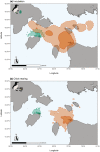Lower nutritional state and foraging success in an Arctic seabird despite behaviorally flexible responses to environmental change
- PMID: 37091555
- PMCID: PMC10119025
- DOI: 10.1002/ece3.9923
Lower nutritional state and foraging success in an Arctic seabird despite behaviorally flexible responses to environmental change
Abstract
The degree to which individuals adjust foraging behavior in response to environmental variability can impact foraging success, leading to downstream impacts on fitness and population dynamics. We examined the foraging flexibility, average daily energy expenditure, and foraging success of an ice-associated Arctic seabird, the thick-billed murre (Uria lomvia) in response to broad-scale environmental conditions at two different-sized, low Arctic colonies located <300 km apart. First, we compared foraging behavior (measured via GPS units), average daily energy expenditure (estimated from GPS derived activity budgets), and foraging success (nutritional state measured via nutritional biomarkers pre- and post- GPS deployment) of murres at two colonies, which differ greatly in size: 30,000 pairs breed on Coats Island, Nunavut, and 400,000 pairs breed on Digges Island, Nunavut. Second, we tested whether colony size within the same marine ecosystem altered foraging behavior in response to broad-scale environmental variability. Third, we tested whether environmentally induced foraging flexibility influenced the foraging success of murres. Murres at the larger colony foraged farther and longer but made fewer trips, resulting in a lower nutritional state and lower foraging success compared to birds at the smaller colony. Foraging behavior and foraging success varied in response to environmental variation, with murres at both colonies making longer, more distant foraging trips in high ice regimes during incubation, suggesting flexibility in responding to environmental variability. However, only birds at the larger colony showed this same flexibility during chick rearing. Foraging success at both colonies was higher during high ice regimes, suggesting greater prey availability. Overall, murres from the larger colony exhibited lower foraging success, and their foraging behavior showed stronger responses to changes in broad-scale conditions such as sea ice regime. Taken together, this suggests that larger Arctic seabird colonies have higher behavioral and demographic sensitivity to environmental change.
Keywords: Arctic; climate change; daily energy expenditure; foraging flexibility; foraging success: nutritional biomarkers; sea ice; thick‐billed murre.
© 2023 The Authors. Ecology and Evolution published by John Wiley & Sons Ltd.
Figures





References
-
- Anteau, M. J. , & Afton, A. D. (2008). Using plasma‐lipid metabolites to index changes in lipid reserves of free‐living Lesser Scaup (Aythya affinis). The Auk, 125(2), 354–357. 10.1525/auk.2008.06255 - DOI
-
- Ashmole, N. P. (1963). The regulation of numbers of tropical oceanic birds. Ibis, 103(3), 458–473. 10.1111/j.1474-919X.1963.tb06766.x - DOI
-
- Bartoń, K. (2022). MuMIn: Multi‐model inference. R package version 1.47.1. https://CRAN.R‐project.org/package=MuMIn
-
- Bates, D. , Mächler, M. , Bolker, B. M. , & Walker, S. C. (2015). Fitting linear mixed‐effects models using lme4. Journal of Statistical Software, 67(1), 1–48. 10.18637/jss.v067.i01 - DOI
LinkOut - more resources
Full Text Sources

